#Bui The Long of Creative Architects
Explore tagged Tumblr posts
Text
Seeing as my internal rewards system has moved on to 'trans fiction' from 'queer horror audio drama podcast' I thought I should do a little roundup of everything I listened to the past few months.
A rough ranking:
Malevolent. Just squeaking into the top spot here based on 1) technical prowess (iykyk) 2) compelling characters and story and 3) they are my blorbos your honor!!! Mind boggling that Harlan Guthrie has so much chemistry with himself.
The Silt Verses. Only topped by Malevolent bc season 1 is not as polished, but it really doesn't matter. Top tier characters, amazing worldbuilding, intricate plotting and it had something to SAY about the casual violence of systems, the nature of hope, the complexity of being human in a world that tries to make us inhuman. Also, it doesn't rely on some thin recording contrivance (a framing device that has its place) and instead truly takes the mantle of audio drama without apology.
The White Vault. On the topic of framing devices, TWV has a very cool take on found footage recordings. A group of [researchers/archeologists] are sent to investigate a remote site in [Svalbard/Patagonia] and the podcast is structured as a documentarian presenting the notes, recordings and diary entries in a reconstructed timeline. My favorite element is that many of the characters don't make their notes in English, so the segments will often open with the VA speaking German, Spanish, Mandarin, Icelandic, Russian, etc etc before fading into the translation. There are miniseries between the seasons available on their patreon and they were so worth the $10 I paid to access them for a month. Reveals are slow, but worthwhile, and the mythology built for the show is highly original and intriguing.
Deviser. A one season contained story from Harlan Guthrie of Malevolent. Scifi, psychological, lots of wet awful body horror. If you're a fan of Harlan wimpering into a mic, you'll love this one.
WOE.BEGONE. Long, ongoing, and so so so far from the original premise it's hilarious, I'm ranking this higher than it maybe deserves for two factors 1) the creator and the VAs are clearly having a blast and 2) it's riding the line of taking itself serious despite a premise that invites irony poisoning without becoming too wrapped up in itself. It's fun, I think, that keeps w.bg strong.
The Magnus Archives. Should this be one up? Probably. But everyone bloody well knows tma by this point, it's good, great even! Beyoncé of horror podcasts.
I Am In Eskew. Only knocked down due to the actually godawful sound quality. Truly unsettling stories though (the one with the building architect haunts me) and a surprisingly realistic conclusion. You can see the bones of The Silt Verses here, from the same creative team.
The Magnus Protocol. Everything above this is there due to originality. As a sequel series, TMAGP will always suffer in that measure. However, I like our new cast and I do love an alternate reality. Curious to see where season 2 takes us. I'd like to kill Mr Bonzo in a fire.
The Inexplicables. Another one season story, this time from Rusty Quill, with really fun, flawed characters and no recording framing device!
Wolf 359. Storywise, great! Characters, excellent! Kicking it way to the bottom bc they just would NOT STOP referencing H***y P****r. Yes, Doug's characterization hangs on excessive reference humor, but that was one well I wish they'd left alone.
Red Valley. Knocked for HP references too (come ON british podcasters, do better) but more importantly for veering WAY WAY WAY WAY WAY too close to real life in season 3 onward. I was here for a horror sci fi story about cryogenics, not to listen to my worst climate disaster fears brought to life via hearing rich old sods try to buy their way out of consequences while the world burns and eco terrorism escalates. Too real. Not bad storytelling, just very much not fulfilling my escapism needs.
It's kinda crazy to me that anytime I mention this genre to normies in my life they say, "oh, like true crime podcasts?" And then I die inside. No dude, like radio drama. Like War of the Worlds.
Anyway, I'm off to get even less relatable by reading a zillion niche trans novels (hello Welcome to Dorley Hall, aka, what if there really was a 'trans cult' force femming dudes to undermine their masculinity? It's amazing how much yarn we can make by subverting the cis gaze.)
#malevolent#the silt verses#the white vault#deviser#woe.begone#the magnus archives#i am in eskew#the magnus protocol#the inexplicables#wolf 359#red valley#tma#tmagp#iaie#w.bg#tsv#horror podcast#💫#malevolent podcast#audio drama#weird fiction#fiction podcast#podcast recommendations
85 notes
·
View notes
Text
Color Correspondences in the Craft
in the craft, colors have their own correspondences and symbolism. Here is a list I have compiled of some basic colors and related correspondences to get you started ! - Leviathan
Red:
Fire (aries, scorpio, Mars influencing Saturn)
passion, fire, courage, strength, power, joy, renewal, energy, health, motivation, desire, ambition, leadership, self-esteem, business deals, combat, confrontation, buying and selling mechanical things, repairs, hunting
Pink:
Venus (influencing Mars)
personal success, self love, personal harmony, friendship, calming, romance, harmony, passion, partnership, getting a move-on, physical energy, sex, action, exercise, surgery, buying, selling, & adopting animals, gardening, woodworking, new beginnings, honor, morality, emotions, femininity, breast cancer, homosexuality, compassion, relaxation, infants.
Orange:
Fire (sun, Leo, Saggitarius)
relieving depression, feelings of abandonment, increasing opportunities, happiness, mental alertness, breaking down barriers, material gain, kindness, sealing a spell, harvest, strength, dominance, legal matters.
Yellow:
Air (taurus, libra, Mercury)
healing, friendship, increase productivity, remove negative thinking, increase creativity, inventiveness, prosperity, self-esteem, beauty, life, humility, intellect
Gold:
sun
money, inspiration, prosperity, wealth, power, divine masculine
Green:
Earth (Aquarius, Cancer, Venus, Mercury)
increasing love and trust, faeries, general healing, wellness, transformation, new beginnings, prosperity, money, career, employment, hope, immortality, rebirth, garden & herbal magic, fertility, luck, courage, change, peace, harmony, relationship success, beauty, soulmates, artistic ability, affection, partnerships, alliances, grace, luxury, marriage, social activity, decorating, cosmetics, gifts, income, gardening/gardeners, architects, artists, music, painting, poetry, courtship, dating, household improvements, planning events, shopping.
Blue:
Water (Capricorn, Aquarius, Pisces, Virgo, Jupiter, Moon)
increase wisdom, wealth, joy, opportunity, patience, peace, truth, loyalty, meditation, introspection, insight, happiness, fidelity, remove confusion, the ocean, elevation, calming, long distance travel, higher education, political power, religion, philosophy, forecasting, broadcasting, publicity, expansion, luck, growth, sports, horses, legal matters, doctors, guardians, merchants, police, psychologists, charity, self-improvement, research, studying, reading.
Violet/Purple:
Capricorn, Gemini, Saggitarius, Mercury, Saturn, Jupiter
clairvoyance, relief of emotional hurt, spiritual protection, heal wounded pride, spirituality, wisdom, increasing psychic powers, meditation, justice, forgiveness, humility, the occult, hidden forces, secret dealings, memory, intelligence, communication, messages, students, merchants, editing, writing, ambition, contracts, kinship, progress, visiting friends, astrology
White
Pisces, moon
safety, protection, transformation, enlightenment, connection to higher self, becoming more outgoing, relieving shyness, the cycle of life, freedom, health.
Black:
Saturn
use in combination with white to represent balance, opposites, union of opposing forces, divination, beginning, creation, rebirth, absorbing energies, patience, binding, stability, neutralizing forces, material gain, protection, karma, death, manifestation, law, understanding ones limits, overcoming obstacles, challenges, tests, sacrifice, separation, criminals, civil servants, plumbing, justice, wills, debts, discoveries, elders, truth
Gray & silver
Moon
Divination, secrets, psychic awareness, divine feminine.
Brown:
Earth(Scorpio, Capricorn)
security, friendship, animal magic, nature magic, generosity, fruitfulness, new beginnings, harvest, health of pets & livestock, endurance, grounding, strengthening, solidifying, sound decision making, improved concentration, focus, telepathy, finding lost things, anything to do with animals.
#baby witch#beginner witch#cottage witch#green witch#little witch academia#pagan witch#tarot witch#witch#witch community#witch aesthetic#colors#correspondence#color correspondences
21 notes
·
View notes
Text
Cruising
Joshua Goldman grew up in a rich family. His parents have always invested in real estate. They were hardworking though and gave him the values of integrity and determination.

From a young age, Joshua knew he was different. He had a keen eye for fashion and design, and his creativity set him apart from his peers. However, growing up in a conservative community, he faced adversity and discrimination. It was during his teenage years that he discovered his sexual orientation, and he struggled to find acceptance and support.
But despite the challenges he faced, Joshua never let his circumstances define him. He worked hard in school and graduated to a prestigious university. It was during his time in college that he discovered his innate business acumen. He excelled in his studies, focusing on finance and real estate, and his professors saw something special in him.
After graduating at the top of his class, Joshua set out to make his mark on the world. Armed with his knowledge and ambition, he dove headfirst into the real estate industry. He started small, flipping houses and investing in properties, slowly building his empire. At a very young age he took over his parents company.
It wasn't long before Joshua's savvy business sense caught the attention of wealthy investors. With their financial backing, he expanded his operations, diving into commercial real estate and luxury properties. His ventures took him to every corner of the globe, from the bustling streets of Dubai to the serene beaches of Bali.

As his wealth and influence grew, Joshua found himself longing for something more. The business world was exhilarating, but he yearned for a sense of fulfillment that money couldn't buy. It was during a trip to the Mediterranean that he had a life-changing experience.
The shimmering blue waters of the Mediterranean called to Joshua like a siren's song. The luxurious yachts that dotted the coastline captured his imagination, and he knew he had found the missing piece of his puzzle. He wanted to live a life of freedom, surrounded by beauty and opulence. And so, he set his sights on acquiring a yacht of his own.
Joshua spared no expense when selecting his vessel. He enlisted the help of the most talented yacht designers and naval architects in the world. Together, they created a floating palace that would become his home away from home. The yacht was a sight to behold, boasting state-of-the-art amenities and luxurious accommodations.
Joshua's summer routine became the stuff dreams were made of. From May to September, he would embark on a journey across the Mediterranean, his yacht docking in a new harbor every morning. As the sun rose, he would lace up his sneakers and set off on a run through the picturesque streets of each city or village, guided by his dedicated personal trainer.
After an invigorating run, Joshua would indulge in an hour of fitness at the most exclusive hotels and resorts that he owned in the region. Sweating it out in luxurious surroundings became his morning ritual, a way maintain to his physique and recharge his for energy the day ahead.
By lunchtime, Joshua would return to his yacht, already tackled the to business side of his empire. Meetings with clients and investors filled his mornings, as he strategized and negotiated deals from the comfort of his floating palace. The yacht provided the perfect backdrop for his high-stakes discussions, its opulent interiors exuding an air of sophistication.
Despite his high-powered lifestyle, Joshua never forgot the value of companionship. He surrounded himself with a carefully selected entourage, a tight-knit group of individuals who became like family. Two hospitality managers attended to his every need, ensuring that his logistics were flawlessly arranged. His personal trainer, chef, and assistant chef also had their designated spaces on the yacht, their expertise enhancing the experience for Joshua and his guests.
And guests there were aplenty. Joshua's generosity knew no bounds, and he would often invite his friends and family to join him on his summer escapades. He would fly them in from around the world, ensuring that they were treated like royalty from the moment they stepped onboard. Lavish breakfasts were served, either in the privacy of their rooms or on the sun-drenched deck. Joshua prided himself as the perfect host, ensuring that his guests were always entertained and pampered.
Joshua's yacht became a hub of excitement and joy. He organized breathtaking excursions, taking his guests to secluded beaches and enchanting Mediterranean islands. The days were filled with laughter, sun-soaked adventures, and endless opportunities for relaxation and indulgence.
As the sun set, the yacht transformed into a vibrant party scene. Joshua's guests would gather on deck, clinking champagne glasses, and dancing into the wee hours of the morning. And yet, amidst the revelry, Joshua remained the picture of composure. He knew how to pace himself, rarely imbibing in excess and always encompassing himself with responsible behavior.
As the summer months drew to a close, Joshua reluctantly bid farewell to the Mediterranean and returned to his beloved New York City for the fall. The concrete jungle provided a stark contrast to the azure waters he had become accustomed to, but he found solace in the vibrancy and energy of the city.
The winter months were divided between two paradises that Joshua held dear. From November to January, he would retreat to his Tulum jungle villa, immersing himself in nature's embrace. The serenity of the jungle served as a respite from the stresses of his business, allowing him to find inner peace and clarity. Or go to his beach house in St Barth’s.
Then, from February to March, Joshua would trade the tranquility of Tulum for the exhilaration of the European Alps. Gstaad became his seasonal home, a playground for the elite and a winter wonderland for adrenaline enthusiasts. He would carve his way down the snow-covered slopes, letting the crisp mountain air invigorate his spirit.
And so, the seasons changed, and Joshua followed suit, always seeking out the next adventure. With spring came the promise of discovery in a new city, a chance to explore trendy bars and restaurants and mingle with sexy, like-minded individuals. He reveled in the nightlife, surrounded by beauty and opportunity.
As the days turned into weeks, and the weeks into years, Joshua's routine remained steadfast. He had found a life that brought him joy, fulfillment, and success. His multi-billion-dollar empire continued to flourish, and he became a role model for those who dared to dream.
And so, as the sun set on Joshua's yacht, signaling the end of another perfect day, he retired to his luxurious chamber. He knew that tomorrow would bring new adventures, new challenges, and new opportunities. He lay his head on the soft pillows, his mind at ease, and drifted off to sleep.
The morning would come soon enough, and Joshua would rise the with sun, ready to embrace the world that lay before him.
Part 2, Thibault
During a glamorous party in Paris, a young and handsome man named Thibault had just graduated from university. With his clever mind and social charm, he caught the attention of the city's elite, including the Joshua

Joshua, impressed by Thibault's presence, invited him to join him on his private jet, traveling to parties all over Europe in the month of April. Thibault and Joshua quickly became a great match, and their friends adored them as a couple.
As summer approached, Joshua extended an invitation to Thibault to join him on his luxurious yacht. It was the perfect opportunity for Thibault to travel before starting work, so he eagerly accepted.
The summer adventure began in Beirut, where Joshua spent his mornings running on the shore with his personal trainer, followed by intense fitness workouts and meetings with investors and other important business associates. Lunchtime was usually spent back on the boat, hosting grand parties with influential people.

During the first two weeks, Thibault and Joshua had a wonderful time, enjoying each other's company and indulging in the delicious food onboard. However, Thibault soon realized that the extravagance was taking a toll on his body. Feeling a bit chubbier, he noticed that it actually turned Joshua on, leading to their intimate moments being even more passionate than before.

Determined to look his best, Joshua took Thibault on a shopping spree, buying him new Louis Vuitton trunks and tailored suits to enhance his appearance. Thibault also attempted to keep up with Joshua's fitness routine but struggled to find the motivation. Late-night parties and exhaustion from socializing left him feeling tired and slightly hungover.
After four weeks, Thibault started to notice that his jeans no longer fit him. At first, he assumed it was due to the staff on the boat washing them at too high a temperature. However, during a shopping trip, he realized that he had gained a whole size. Troubled by this discovery, he decided to have a workout session with their personal trainer, but unfortunately, it didn't go well. Thibault discovered that he had gained a shocking six kilograms in just four weeks, which was more than he had ever weighed in his life.

Thibault discussed his concerns with Joshua, proposing that they schedule a session with the personal trainer to address the issue. However, Joshua denied the request, explaining that the trainer was too busy with his own online fitness company and would disrupt the guest schedule. Feeling guilty and wanting to show his appreciation, Joshua bought Thibault a Rolex watch. Despite the weight gain, Joshua couldn't resist his attraction to Thibault's new size, and their intimate moments continued to be filled with passion.

As the summer went on, Thibault and Joshua traveled to various destinations along the Croatian coast, Venice, Puglia, Capri, Rome, and other glamorous Mediterranean locations. They attended lavish parties with high-end guests, including celebrities and royalties.

Indulging in more snacks and champagne, Thibault's denial about his weight gain persisted, attributing it to Italian sizes rather than accepting the reality. Meanwhile, Joshua maintained his discipline, going to bed on time, and abstaining from alcohol.

Three months had flown by, and Thibault and Joshua had visited every desirable harbor in Europe. Their bond had strengthened, and Joshua couldn't believe that Thibault had made it through the summer without any issues. Other companions had wanted separate rooms or even left after only four weeks. Joshua proposed that Thibault join him in his New York City apartment for the fall, with the potential of spending Christmas and New Year's Eve with his family in Mexico and St. Barths if everything went well.
In the last harbor before their return, Thibault felt like an entirely different person. He had grown larger, and Joshua decided to them treat to a weekend at a lavish spa resort in the area. Stepping on the scale after three months of not seeing his weight climb, Thibault was shocked to discover that he now weighed 120 kilograms. Conflicted about his new appearance, Thibault wasn't sure if he liked it, but Joshua loved it and had no intention of making him lose weight.

#fictionalweightgain#maleweightgain#maleweightgainstories#weightgain#weightgainstories#fictionalstories
113 notes
·
View notes
Text
What if Furina wasn't a girlfailure for 500 years? (Shorteneder Version (still long))
Off the top, I'm not a lore expert. If this doesn't make sense lore-wise, feel free to tell me all about it. Expect it, even. I just wanted to write this down because after experiencing her story, (when it dropped months ago in version 4) this idea just never got out of my head. I process media in a way where I'm constantly thinking on the level of "why did the authors make these specific decisions?", and I couldn't shake the feeling that the authors lacked a bit of imagination when considering just how long 5 centuries is. I have like over a thousand words of why I think this which includes a discussion of historicity and biblical allusion. I cut it all -- nobody wants to read that.
That being said, this is somewhere between a rewrite and like a notes document. In this, Furina is still fundamentally the same character. Her personality and mannerisms should be basically identical, even if she's more competent. This rewrite hopes to preserve the main beats of her arc: The confrontation by Arlecchino, the disaster which causes people to doubt her godliness, the trial, and a backstory which makes you pity her. I'm going to lay these out in chronological order, rather than plot order.
Backstory
Focalors told Furina the prophecy, leaving her terrified and overwhelmed. All the people of Fontaine will drown, and she will be left alone, crying on her throne. Despite her horror, some rebellious gumption rose up in her soul and allows her to steel herself. Much like Focalors before her, despite being handed a doomed situation, Furina decided that there was nothing she couldn't fight back against, even fate. Knowing that there's a flood coming, she put together a plan.
Furina decided that she would hold grand competitions every decade, gathering the greatest tinkerers, engineers, architects, anyone with interesting ideas in her nation to show off their most creative inventions, no matter what those inventions did. She would call these competitions Fontaine's Utopique Rendezvous for Industrie Nouvelleté, et Audacé* (FURINA). As their god, Fontainian culture was her privilege and responsibility to shape, so innovation and technological advancement would be placed at the core. With great patience, she would lead Fontaine from the Medieval age to the Industrial revolution. During FURINAs, as she strolled through the streets of Fontaine, the entrants displayed and described their creations to her to each would be personally judged by her. There is not a maximum or minimum of winners, there are only those who do and do not catch the eye of the Hydro Archon. At the end of the competition, she rewards the winners with her patronage to sponsor them and their ideas. These winners would come to be informally known as FURINA Scholars. She created these patron relationships usually with the goal of creating or improving a public infrastructure project or taking a particularly fascinating or promising invention from an impractical novelty to mass producible technology that anyone could use. FURINA Scholars had a hard time limit of 10 years, being required to present their progress publicly at the next FURINA by the latest. The results of these varied from practical, aesthetic, to insanely niche novelty toys you'd expect a French aristocrat to buy.
A lot of real kings and queens can't dedicate themselves to advancement in this way because their bureaucracy, the power structure beneath them, know that they don't have to be beholden to them forever. Each bureaucrat knows there will be another younger ruler eventually who would could be manipulated into giving more to them and less to the people. Not so with Furina. She would use the royal coffers however she wanted to, and nobody could speak out against her, lest they be hit with the combination blasphemy-treason from the judgement of the Oratrice Mechanique d'Analyse Cardinale.
(*This is intentionally butchered French, in line with the Oratrice Mechanique d'Analyse Cardinale. If you can't read it, it's basically Fontaine's Utopian Conference for Industry, Novelty, and Audacity. It's a funny acronym, and a bit on the nose in multiple ways, but I think it would be something she would come up with. I imagine that Furina would never call it FURINA, but over time people would start calling it "the FURINA" and eventually "the FURINA de Fontaine" in the way that people always start butchering acronyms when they become normal words.)
Every day, Furina's free time between these FURINAs was spent studying, learning, testing, and inventing in her study. If Fontaine was to be flooded by rising waters, she herself would be dedicated to finding a way to allow Fontaine to survive any flood. Out of the public eye, she found ways to spend every spare moment honing her skills and iterating her designs. She quickly learned to dismiss attendants that came to her with some spurious legislative work whenever she left the Opera Epiclese. Go to Neuvillette! She had a duty which so obviously rendered such things spurious. Paperwork? When Fontaine could be drowned any year now?
(Just as in the real story, it's implied that Neuvillette is vaguely aware that she must be working incredibly hard, but she deliberately hides her toil from everyone, including him.)
Obsessively, tirelessly, she toiled single-mindedly towards in designing super-structures capable of diverting, pumping, or otherwise controlling vast amounts of water. As she would sketch mockups of grand designs, she was thinking of public excuses for doing this rather than just using her "archon powers." It would make her seem more benevolent to say something like "I cannot be everywhere at once, and I need to be sure that the people of Fontaine shall not suffer a disaster under my rule, even out from under my watchful gaze." It was even true, in a way. Over the centuries, she carried out plans for every major Fontaine settlement's coastline and the entire capitol city to be protected by works of engineering which were equally intricate and gargantuan. At the same time, they balanced preserving the beauty of coastlines and consistency in aesthetic that is paramount for France. She directed the creations of these superstructures over generations with clarity and consistency in intent. She eventually became capable of concocting ideas that were not possible with currently invented technology, her innovation outdoing the rate of technological advancement. That meant she was not nearly finished. Waiting for technology to catch up with her ideas was always a good opportunity to update the physical build of her superstructures.
Despite her having already gathered vast and unmatched generational knowledge after her first full century of study, she still continued FURINAs to find the best and brightest minds of each generation. (If it must be done for Genshin's thematic consistency or ideology, these can all even be vision holders). These inventors who all grew up in the context of Furina's unparalleled genius had the privilege of standing on the shoulders of a giant. Innovations begot innovations, forming a virtuous loop which drove unprecedented progress in industrialization leading to evolutions in technology especially in civil engineering and hydrodynamics. As Furina's knowledge and mastery over engineering slowly but surely surpassed mortal limits, FURINAs seemed to be more and more judged based on eccentric, incomprehensible whims. With relative frequency, participants would watch seemingly impressive inventions be passed over, meanwhile random toys that just made her giggle and applaud would win. She would say "I just find these trinkets so charming!" but in truth, she saw potential in central conceits in inventions that had the chance to change the underpinnings of Fontaine's infrastructure. Or she just genuinely found them charming.
As time passed, Furina's structures continually improved to a point that they did not just avoid, but very publicly Dominated countless floods and storms that would have been disastrous otherwise. These creations legitimized her godhood and won her adoration in the eyes of the people, who wove countless folktales over the ages telling the tales of Furina's power - herding hurricanes and subjugating tsunamis. At the same time, this made her prodigious skill for the dramatic arts even more impressive through the plurality of her talents. This resulted in many full circle moments, where Furina would play herself in epics about her overcoming disasters, not that she wrote, of course. These would sometimes exaggerate her powers, like giving her omniscience or visions of the future, the perfect designs flowing freely and naturally from her hands, as though they were as effortless as breathing.
Of course, she was not truly invincible. Slowly, she started to fray. As new innovations became more difficult, technology caught up to her designs. After the superstructure renovations commemorating the 4th century of her rule, she was distraught. This was the first time she had updated her superstructures without the plan for the next one at least partially completed. She needed to spend more of her energy pondering, as just her "free" time was insufficient. This led to her to becoming more absentminded during official duties, having forgone sleep or being still caught up ruminating on how to optimize designs, improve existing technology, or apply them in a novel way, but for some reason nothing was coming to her after a few years of different experiments and trials. Even in discussions with her FURINA Scholars, they stopped having new ideas in hydrodynamic engineering projects, being drawn towards other directions where they wouldn't need to compete with god. As she crossed the 450-year mark, she was becoming increasingly aware of the fact that her designs weren't nearly enough to protect the entire country and even further from perfect. For the better part of the last century, any improvement had been like trying to squeeze water from a stone. In the last ten years, she has probably improved her latest flood barriers by less than a liter of water. 30 more years restarting from scratch over and over with her current knowledge, no meaningful improvement.
For the 48th FURINA, she decided out of desperation to hold a hydro-themed FURINA. As she walked the streets of Fontaine, talking to each inventor as they presented their work, she was distraught. A marked decrease meaningful innovation. Worse than this, she noticed that inventors were less interested in creating submissions for this FURINA. The sentiment she was picking up on was that they felt futility in even trying. What was the point of trying to innovate in a field that they can hardly understand? The cutting edge of hydro-related innovation was driven so far by Furina that they felt mortals need not apply. Who could even be given the privilege of becoming the decade's FURINA Scholars from such a lackluster field...? As always, she found a way to get out of a dismaying situation. She crowned herself as the winner, made a grandiose speech about who she was still unmatched in the domain of Hydro, and unveiled her side project of the Aquabus.
At the end of the hydro-FURINA, Furina had never felt so alone. For the first time since her first decade, she had not the faintest idea of what to do from here. Nobody did. She had already pushed to and past limit of her knowledge, of her peoples' knowledge, and the limits of material possibility in Teyvat. All of these centuries had passed her by, all these sleepless nights, all her evolutions in the design of Fontaine to fortify it, for what? A worm, wriggling on a stone, drying out in the sun. If she failed to prevent the flood now, what would any of that time mean?
Furina found herself standing in her study, towering alone above the room crowded with her innovations, blueprints, experiments. Her gaze floated over each page; her life's work surrounded her. Broken mechanisms, meaningless scribbles, trials without results. Countless wasted mines of materials, countless wasted gallons of ink, and countless wasted centuries of labor by her precious hardworking people. Not realizing she was fully sobbing, she slumped to the floor, picking up the blueprint of one of her latest redesigns. She couldn't see anything aside from bodies floating in the water. Her mind replayed the faces of every person whom she's ever worked with or learned from, whose families she met, and every child of Fontaine whom she watched grow. They died all the same. Her vision started to swirl as their faces closed in around her. They rose up all around her from the waters in her blueprints. She grasped at them desperately, begging them to stay with her. On her side, shaking, sobbing, with a bundle of ripped and crumbled papers clutched against her. For the first time since she was told the prophecy, she felt truly helpless. Out of the corner of her eye, she saw her mirror. She scrambled through a carpet of papers, trinkets, and tools to touch her forehead to the glass.
"Mirror me, I-I've been doing everything I can. Our people have been trying, too! They worked so very hard, and they've built my all of designs beautifully."
Silence.
"Please, tell me you know something, anything that I can do now. I need to know. I can't let it end like this."
Silence.
"I never imagined that... that we'd even make it this far, mirror me." Furina was sitting now. With a smile on her face, she still couldn't stop the tears as she leaned against the mirror. "They truly are my pride and joy." Barely more than a whisper, an "I'm sorry" escaped her lips.
She had been doing her best for so long, but she had certainty now. Her best would not be enough.
A real Archon would be able to overcome this. On her own strength.
Furina cursed her inadequacy, mourning the people of Fontaine in her heart. It was torture. Every day, her job was to look at all the wonderful people that she was failing every day, people whom she was dooming through her weakness. During trials, she entirely lost the ability to focus on what's happening in front of her, her comments in the Opera becoming nonsensical and detached. More often, she handed off interpretations directly to Neuvillette, and tears sometimes leaked through when doing her fan meetups. Somehow, she still managed to hide her turmoil with audacious bravado as always. She felt more internally frantic as more years came and went. It was like desperately treading treacherous waters as she needed more and more effort to simply maintain surface appearances. The 49th and 50th FURINAs were brief respites from the gloom. Despite all of the stress in her life, the silly novelties of her people could still bring her joy. But when she returned to her private abode, she found that sometimes, not every time, she didn't want to work anymore. Instead, she would lay in her bed. Stillness without rest.
Her dead eyes blinked slowly, making no tears. She pondered, "How long has it been?" When she stared down at her hands, she could still see the souls of every Fontanian leaking through her fingers. The harder she tried to hold onto them, the further they'd splatter away. If only she had more time. Time, as always, passed anyway.
Plot time
Now, this is when the incident happens. Furina just hit rock bottom as the Traveler comes to town. Everything in the plot that played out in the main story happens mostly the same. This retroactively explains why all of Furina's arguments in the Mysterious Disappearances trials are so weak. Sure, she has a lot of experience presiding over trials, and it may be a top priority for her since this Furina is also excited about the opportunity for a Grand Trial that Focalors told her about, but she is so far from being on the top of her game right now.
Over centuries, Furina built this idea of infallibility, weaving a narrative to reaffirm her godhood. Fontainians believed that because each design was crafted by Furina directly, she made sure that none of them could ever fail using her uniquely intimate knowledge of the Hydro element. When Arlecchino called for an audience with Furina about the impending incident of unprecedented scale in Poisson, Furina was not just small or helpless with no excuse. Furina imposed upon Arlecchino as a god in her own land. There was to be absolute faith in her creations. Her power over hydro would never allow a Fontainian to come to harm.
"What does a puny rat like you think you know? I've thrown out socks that were older than you. Smarter, too."
Like a true god, she gaslit Arlecchino about what information Arlecchino had regarding the flood coming to Poisson. As the Regina of All Waters, not only did she have access to more information through her national information network, she also simply understood Hydro in a way that mortals couldn't comprehend. This is one of the only times that Arlecchino would seem even a little shaken by anything.
Furina didn't refuse to take precautions because she's a depressed NEET; Furina placed herself in this position where she simply could not possibly even suggest taking precautions. That would imply to Arlecchino and by extent the people of Fontaine that there was a weakness in her absolute power over Hydro and, by proxy, her status as archon. In previous centuries, she had only ever commanded upgrades to earlier designs as technology advanced to allow her to better realize her intended designs.
This made it all the more world-shattering for Fontainians when the symbols of their god, their faith in her power, warped and bursted under the immense pressure of more water than seemingly possible in nature (this flood is mega buffed in this plotline). The damage was horrific, but would be much much worse if not for the efforts of Arlecchino and the Spina di Rosula. This was the first time that anyone has doubted her as god, and nobody who doubted even wanted to because they've had faith for so long.
The trial proceeds nearly exactly as in the game, with the additional wrinkle that her centuries of age needs to be a hint as to how she could be such a genius of engineering without being the Hydro Archon.
After the trial
After her liberation, much of Furina's story is the same. She is so incredibly burnt out after finally being free that she has the same despondent attitude as she does in the game. She doesn't really invent in her free time, as she's a bit traumatized by the memory and sensation of using those tools. Even picking up a screwdriver reminds her of hundreds of years of sleepless nights experimenting desperately with the weight of the world on her shoulders.
The only real things that would change after the Archon quest would be -
In her character quest, Furina surprises everyone by proudly declaring her return to the stage on her own, having thoroughly enjoyed her time with the ragtag troupe. After a handful of lifetimes of endless labor with a dash of theatre, having the opportunity to do theatre full time sounds like great fun. The reason that she wouldn't have started before this quest is because of her burnout and exhaustion buildup ofc.
In Roses and Muskets, just take out all the times where Furina's trauma is played for laughs, or times where she's outwardly timid in a public conversation, especially when directing. Furina's reaction to imposing in public situations should be so well trained after playing archon should be instinctual after 500 years that she never gets caught slipping by an unfortunate circumstance. In private, she can still of course be her quirky self.
At the end of Roses and Muskets, she's not awkward about receiving the trophy. She's really happy, overjoyed even, having not been able to participate in any competitions herself in Archon era.
During Lantern Rite, Furina is on Cloud 9, going crazy and stupid finally leaving the country. She is positively giggly being charmed and intrigued by every single little thing in Liyue which is different from Fontaine. She walks around the street asking people about ridiculous and mundane things, like "What wood is this fence made out of?", "Do all your boats really need sails? Where are their engines?", "What techniques were employed to build villages on all these hills?", "Where is the toilet in this establishment?... oh Me... running hydro? DO YOU NOT HAVE ANY PLUMBING-", and various other questions about architecture, technology, and everything else she'd notice as someone otherwise incredibly knowledgeable who'd been stuck in one country for centuries.
Anyway, as a thanks for reading my yap, here are some drawings of tinkerer Furina loving life


#Tinkerina#genshin fanart#rewrite#character redesign#au idea#genshin#i love furina#maybe i should repost these drawings separately for anyone who doesn't want to read several thousand words of yapping#don't expect much more of this#i meant to give her a teardrop shaped gold pocket watch but i forgot to add it#in this essay i will#essay#how to stop my yap#first post#so yeah#if i don't post this now i'll never finish anything ever#furina#i want to yap about every decision i made when designing her too but like this is long enough so . 3.
17 notes
·
View notes
Text
How to save your brain from being eaten by AI (maybe): keep a sketchbook
At the beginning of May I started bookmarking photographers who are using AI in interesting ways, to add to my Instagram collection of digital art references (#artdirectionneversleeps). Later that month I did my own first experiments using NightCafe to visualise ideas for a client. It was entertaining and frustrating, partly because of my lack of prompt skills, and partly because the "styles" you could apply to your "artwork" looked exactly like bad fantasy art from the 1980s.
However, by June, photographers I was working with were using Midjourney to conceptualise setups – still with a bit of that tacky SciFi book cover feel, but it was proving genuinely useful to talk about how sets might be designed, for instance. By July, I was seeing film directors use AI for pitching storyboards, and my lovely students at Condé Nast College of Fashion and Design using it for presentation mock-ups.
That's just three months. From AI being a "what?" to becoming a completely logical, natural part of the image-making process, for at least some parts of the creative industries. The speed of change is head-spinning. And this is just the beginning.
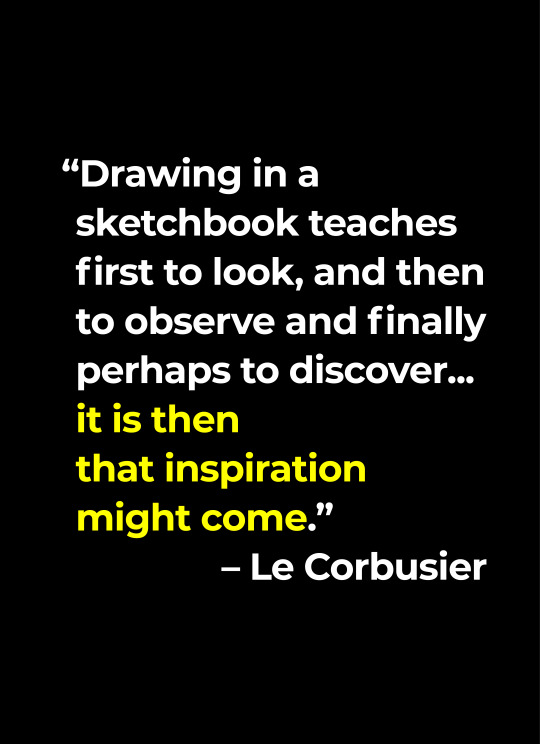
Meanwhile, also in May, I was teaching at CNC on a really fun module about Brand Identity Design. Part of this involved the students keeping a sketchbook, to explore and develop their ideas. One of my lectures was about WHY people keep sketchbooks, and I illustrated several points with quotes from designers, architects and artists, and pages from my own sketchbooks from waaaaay back in the day.

Because WBITD, when I was an art student, I kept sketchbooks constantly. Not only was it a course requirement, for me it was also a way to stave off boredom and depression: it's hard to think negative thoughts when your brain is absorbed in analysing the curves of a hand or a coffee cup or a flower. When my best friend and I used to Interrail around Italy, I would draw our cafe tables and the local streets, and we'd get rewarded with extra drinks and desserts by kindly waiters.
Somewhere around the mid 90s I gave up sketching, partly because life got more hectic, and partly because smartphones got invented. When Emma and I started the BID course this summer, it had been a very long time indeed since I cracked open a sketchbook. And, erm, even though I did buy one – a lovely, spiral-bound, hard covered book with wonderful heavyweight paper, from Seawhite of Brighton – it took me another few months to start using it.
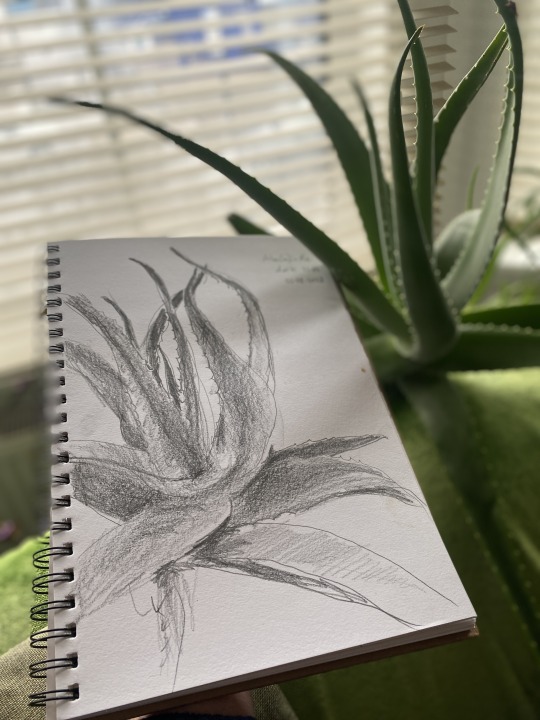
Two things pushed me into finally starting: firstly, it's #drawugst and I thought I should try a drawing a day, every day, during August. I started on Tuesday, August 1st, with a graphite pencil sketch of my aloe plant. I did it in semi-darkness, around 9pm, and my hand-eye coordination felt a but rusty, but following the heavy curves of the plant was satisfying.
On Wednesday I drew fallen agapanthus blossoms, playing with coloured marker pens (of which I have a ridiculously huge collection, almost never used). This was a reminder of the importance of not trying to control the end result while you're sketching. Because you just can't.

Yesterday evening I scribbled our messy after-dinner table. I used the graphite pencil, a Koh-I-Noor Hardtmuth charcoal pencil, and an Edding 1225 calligraphy pen – and blackberries. The fruit, not the redundant communication device. Blackberry juice is a fabulous art material – it gives this beautiful purple inky result, and it's such a pleasure to smear all over the paper. I'd picked the berries earlier this evening on Wormwood Scrubs, just to add to the satisfaction of the whole experience. (And this morning I made almond milk smoothies with the rest of them.)
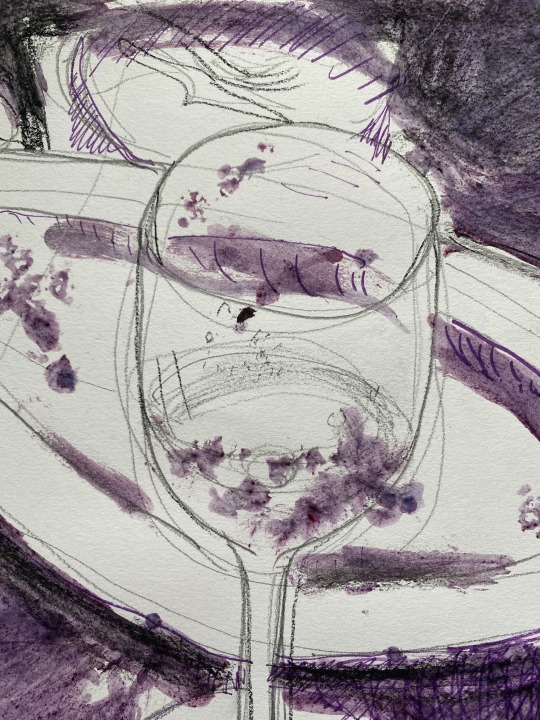
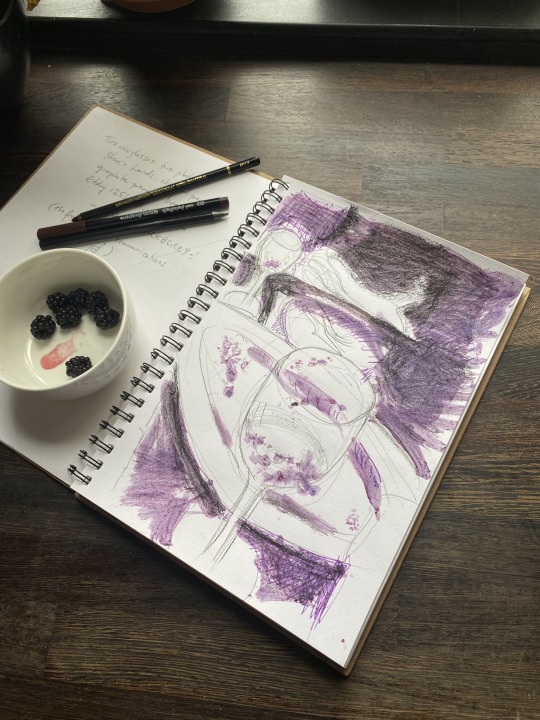
The other thing which made me finally restart a sketchbook after all this time is AI. I can see that it is just going to get bigger, more powerful, and more indispensable in my industry. I'm not going to worry about losing my job to a bot (I don't have "a job", anyhow), but I am concerned about what it will do to our creativity.
When you use one tool extensively it starts to train your brain, you develop habits and shortcuts. It's one thing to have tricks for making the most of Photoshop, or to have routines when you set up an InDesign document. But when you're trying to generate ideas you need to keep an open mind. To look at things from different angles. To look again, look harder. Try wacky ideas. Draw with your food. Stick things onto the pages. Doodle. Take a line for a walk. Write notes to self. Be creative. Be messy. Be human.
5 notes
·
View notes
Note
List 5 things that make you happy, then put this in the askbox for the last 10 people who reblogged something from you. learn to know your mutuals and followers. I hope you're having an amazing day/night!! (*^3^)/~♡
hi! hope youre doing well, i dont think we've ever talked, but i really like your posts ❤️
Hello! Thank you for the message. I’m doing well. Chain ask games are curious… I guess it’s similar to passing around a note with a little message on it.
Is it just a matter of talking about myself? Very well, I’ll comply. I suppose reflecting on things that bring me joy is good.
1. Potato wedges. They’re really nice you know? They’re conveniently-shaped so you can pick them up by hand (unlike say round breakfast potatoes) while having them still tasting like potato🥔
2. Recently I’ve started reading the manga Inside Mari by Shuzo Oshimi after buying a physical copy of volume 2 not long ago. How do I say this… It feels nice holding a physical manga again. This one seems to involve a body swap between a guy called Isao Komori and a girl called Mark Yoshizaki, with a dark undertone and themes on sexuality and identity. Well, I’ve only read volume 2 and went back to read volume 1 but I haven’t finished it yet.
3. Creative writing. Can I call it happiness? But I do enjoy it. Exploring characters and seeing how a scene unfolds is satisfying within the moment. As for poetry, it is… my partner, in a sense. In poetry I can talk about my feelings, use metaphors, and play certain roles—things I wouldn’t be able to do as easily in real life. It’s a canvas I can ruin and look back on. …It’s a sword I need to learn to sheath. It’s two mirrors reflecting each other infinitely. Or maybe it’s a duel against my own feelings. I’m using rather intense imagery here, but in the end, it’s many things to me.
4. Another thing that makes me happy… In autumn, the way sunlight hits the orange maple leaves and light them up is quite beautiful. I could stand there mesmerized. Also, recently I saw a nice view. At the edge of the horizon, outlined by building rooftops, was a pink peachy sky… That sort of afternoon sky is beautiful.
5. Video essays on video games with a focus on psychology and/or design/storytelling. Since video games are an interactive form of media, it’s interesting to how certain genres/mechanics elicit certain reactions from the players. I’d recommend the channel Daryl Talks Games since he’s got a nice sense of humour along with the topics for each video. Similarly, the channel The Architect of Games is nice too.
youtube
1 note
·
View note
Text
Who Can Wear 17 Mukhi Rudraksha: Unlocking Its Divine Benefits
Discover who can wear the 17 Mukhi Rudraksha and the powerful spiritual benefits it offers. Learn about its association with Lord Vishvakarman, the deity of craftsmanship, and how it can enhance strength, protection, and prosperity
The 17 Mukhi Rudraksha is a rare and powerful spiritual bead with profound significance for personal, professional, and spiritual growth. Associated with Lord Vishwakarma, the divine architect, this bead brings creativity, success, and protection.

Who can wear 17 Mukhi Rudraksha? Wearing the 17 Mukhi Rudraksha is believed to offer transformative benefits by unlocking divine energies that enhance spiritual awareness and material prosperity, making it an ideal choice for those seeking to amplify their personal and professional life.
To get started, consider checking the 17 Mukhi Rudraksha price for an authentic and valuable purchase.
Spiritual and Astrological Significance
Connection to Lord Vishwakarma: Lord Vishwakarma, the deity associated with the 17 Mukhi Rudraksha, is revered for his creative and architectural skills. The bead is believed to enhance creativity, focus, and productivity, making it ideal for individuals involved in artistic, intellectual, and business pursuits.
Astrological Relevance: The 17 Mukhi Rudraksha is associated with specific planetary energies and is beneficial for individuals with certain zodiac signs. It aligns the wearer's energy with positive cosmic forces, making it especially powerful for those seeking balance and spiritual growth.
Why It Is Ideal for Spiritual Enlightenment: This bead is a powerful tool for deepening meditation, achieving spiritual growth, and enhancing self-awareness. It helps the wearer connect with higher energies, promoting inner peace and balance.
To experience its transformative benefits, you can buy 17 Mukhi Rudraksha price that aligns with your spiritual journey.
Who Can Wear 17 Mukhi Rudraksha?
Business Professionals and Entrepreneurs: Ideal for those seeking to attract wealth, success, and stability in their business ventures. The 17 Mukhi Rudraksha helps manifest prosperity and supports long-term success.
Creative Individuals: Whether you're an artist, writer, designer, or any other creative professional, this Rudraksha enhances focus, stimulates innovative thinking, and boosts creativity.

Spiritual Seekers: The 17 Mukhi Rudraksha is perfect for those aiming to deepen their spiritual practices, including meditation, yoga, and connection with the divine.
Individuals Facing Financial or Professional Challenges: If you are encountering obstacles in your career or financial situation, the 17 Mukhi Rudraksha can provide the strength and guidance needed to overcome these challenges and achieve prosperity.
People Seeking Protection: This Rudraksha is also an effective shield against negative energies, helping the wearer remain emotionally and mentally stable, while also offering protection from harmful influences.
Who can wear 17 Mukhi Rudraksha? It is ideal for those seeking divine protection and inner strength, enhancing their ability to overcome challenges.
Also, check out our other blog on 16 Mukhi Rudraksha Ruling Planet – explore the influence of its ruling planet and how it enhances your spiritual and personal growth
Benefits of Wearing 17 Mukhi Rudraksha
Spiritual growth and inner peace.
Enhanced self-confidence and better decision-making abilities.
Attraction of wealth, abundance, and financial stability.
Boost in creativity, focus, and productivity.
Protection from negative influences and harmful energies.
How to Wear 17 Mukhi Rudraksha
Purification: Before wearing the 17 Mukhi Rudraksha, wash it with Gangajal or clean water to purify it.
Energization: Chant the mantra "Om Hreem Namah" to activate its spiritual energy. This will help align the bead with your personal energies.
Placement: Wear it as a pendant, necklace, or bracelet to ensure that it remains in constant contact with your skin for continuous flow of energy.
Auspicious Day: Monday is considered the most auspicious day to wear the 17 Mukhi Rudraksha, aligning it with Lord Vishwakarma’s blessings.

Precautions While Wearing 17 Mukhi Rudraksha
Authenticity: Always buy the 17 Mukhi Rudraksha from a trusted and certified supplier to ensure you are receiving a genuine bead.
Avoid Impure Activities: Refrain from wearing the bead during impure activities such as consuming alcohol, eating non-vegetarian food, or engaging in negative behavior.
Regular Cleansing and Energizing: Regularly clean the bead and re-energize it by chanting the mantra to maintain its potency and effectiveness.
Conclusion Of Who Can Wear 17 Mukhi Rudraksha
The 17 Mukhi Rudraksha is a powerful spiritual tool that offers a wealth of benefits, including spiritual growth, mental peace, and material success.
If you're wondering who can wear 17 Mukhi Rudraksha, this bead is especially beneficial for those seeking strength, protection, and prosperity.
Whether you're a business professional, creative individual, or spiritual seeker, wearing this sacred bead can help transform your life.
For maximum benefits, consult a spiritual expert or astrologer to ensure the bead aligns with your energy and astrological needs.

FAQs About Who Can Wear 17 Mukhi Rudraksha
Q: Who should wear the 17 Mukhi Rudraksha?A: The 17 Mukhi Rudraksha is ideal for business professionals, entrepreneurs, creative individuals, spiritual seekers, and anyone facing financial or professional challenges.
Q: What are the benefits of wearing the 17 Mukhi Rudraksha?A: This Rudraksha enhances spiritual growth, boosts self-confidence, attracts wealth, improves creativity, and offers protection from negative energies.
Q: How do I ensure the authenticity of the 17 Mukhi Rudraksha?A: Purchase the bead from certified and trusted suppliers, and verify its authenticity through its natural grooves and certifications.
0 notes
Text
Wood Screen Merbau: Elevate Your Space with Elegance and Durability Introducing the Wood Screen Merbau, a stunning addition to any indoor or outdoor space. Crafted from high-quality Merbau wood (Intsia retusa), this wood screen is designed to bring a touch of natural beauty and sophistication to your garden, patio, or interior decor. Known for its exceptional durability and resistance to weathering, Merbau wood ensures that your investment stands the test of time, even in harsh outdoor conditions. The wave pattern design adds a unique, artistic flair, making it a perfect choice for those who appreciate both functionality and aesthetics.
The Wood Panels Wave Pattern Design is not just visually appealing but also highly versatile. Whether you're looking to create a private oasis in your garden, a stylish partition for your outdoor seating area, or an elegant accent wall indoors, these panels are the ideal solution. The intricate wave pattern allows for a play of light and shadow, creating a dynamic visual effect that enhances the ambiance of any space. Its natural wood grain and rich, warm tones add a timeless charm that complements both modern and traditional settings.
Durability meets design with the Wood Fence for Indoor & Outdoor Garden Buildings. Merbau wood is renowned for its strength and resistance to termites, rot, and decay, making it a reliable choice for long-term use. Whether exposed to the elements or placed indoors, these wood panels maintain their structural integrity and beauty over the years. The wave pattern not only serves as a decorative element but also provides a sense of privacy without completely blocking airflow, making it perfect for outdoor applications like garden fences or balcony screens.
Transform your living spaces with the Wood Screen Merbau, where nature-inspired design meets unparalleled craftsmanship. Ideal for homeowners, architects, and designers, these wood panels offer endless possibilities for creative expression. Enhance your garden, patio, or interior with a product that combines functionality, durability, and artistic appeal. Choose the Wood Screen Merbau and experience the perfect blend of nature and design in your everyday surroundings.
0 notes
Text
Wood Screen Merbau: Elevate Your Space with Elegance and Durability Introducing the Wood Screen Merbau, a stunning addition to any indoor or outdoor space. Crafted from high-quality Merbau wood (Intsia retusa), this wood screen is designed to bring a touch of natural beauty and sophistication to your garden, patio, or interior decor. Known for its exceptional durability and resistance to weathering, Merbau wood ensures that your investment stands the test of time, even in harsh outdoor conditions. The wave pattern design adds a unique, artistic flair, making it a perfect choice for those who appreciate both functionality and aesthetics.
The Wood Panels Wave Pattern Design is not just visually appealing but also highly versatile. Whether you're looking to create a private oasis in your garden, a stylish partition for your outdoor seating area, or an elegant accent wall indoors, these panels are the ideal solution. The intricate wave pattern allows for a play of light and shadow, creating a dynamic visual effect that enhances the ambiance of any space. Its natural wood grain and rich, warm tones add a timeless charm that complements both modern and traditional settings.
Durability meets design with the Wood Fence for Indoor & Outdoor Garden Buildings. Merbau wood is renowned for its strength and resistance to termites, rot, and decay, making it a reliable choice for long-term use. Whether exposed to the elements or placed indoors, these wood panels maintain their structural integrity and beauty over the years. The wave pattern not only serves as a decorative element but also provides a sense of privacy without completely blocking airflow, making it perfect for outdoor applications like garden fences or balcony screens.
Transform your living spaces with the Wood Screen Merbau, where nature-inspired design meets unparalleled craftsmanship. Ideal for homeowners, architects, and designers, these wood panels offer endless possibilities for creative expression. Enhance your garden, patio, or interior with a product that combines functionality, durability, and artistic appeal. Choose the Wood Screen Merbau and experience the perfect blend of nature and design in your everyday surroundings.
0 notes
Text
Crafting Your Dream: Build-Your-Own Homes in Nampa
Discover the secret to designing your dream home in Nampa, where creativity meets practicality to create the perfect living space.

Table of Contents
The Process of Building Your Own Home
Advantages of Custom Home Building in Nampa
Cost Considerations and Budgeting Tips
Real-Life Examples and Success Stories
Conclusion
Have you ever dreamed of designing your own home, tailored to your unique needs and style preferences? With the rise of custom home building in Nampa, that dream can become a reality. Building a custom home allows you to create a living space that truly reflects who you are, from the layout to the finishes and fixtures. In this blog post, we'll guide you through the process of building your own home in Nampa, from start to finish.
The Process of Building Your Own Home
Choosing a location in Nampa is the first step towards crafting your dream home. Consider factors such as proximity to schools, work, and amenities, as well as the overall feel of the neighborhood. Once you've found the perfect location, it's time to select a reputable builder who specializes in custom home construction. Look for a builder with experience in creating personalized living spaces and a portfolio that aligns with your vision.
Designing the layout and floor plan of your home is an exciting part of the process. Work closely with architects and designers to create a space that maximizes functionality and suits your lifestyle. From the number of bedrooms to the placement of windows and doors, every decision should be made with your needs in mind.
When it comes to selecting materials, finishes, and fixtures, the sky's the limit. Choose high-quality materials that match your style preferences and meet your standards for durability. Whether you prefer a modern, minimalist aesthetic or a cozy, rustic vibe, your custom home should reflect your individual taste.
Advantages of Custom Home Building in Nampa
One of the main advantages of building your own home is the level of control you have over every aspect of the design. Unlike buying a pre-built home, a custom home allows you to create a space that is truly tailored to your needs and preferences. From the layout to the color scheme, every detail is up to you.
youtube
Custom home building also gives you the opportunity to incorporate energy-efficient and sustainable features. From solar panels to high-efficiency appliances, you can make choices that reduce your environmental impact and save you money on utility bills in the long run.
Another benefit of custom home building is the ability to create a space that reflects your personality. Your home should be a reflection of who you are, with unique touches and design elements that make it truly yours. Whether you love bold colors and patterns or prefer a more neutral palette, your custom home can be a true expression of your style.
Cost Considerations and Budgeting Tips
While building a custom home can be more expensive than buying a pre-built home, there are ways to make the process more cost-effective. Creating a realistic budget and sticking to it is essential. Consider the costs of materials, labor, permits, and any upgrades or customizations you want to make.
When it comes to designing your home, prioritize the elements that are most important to you and be willing to compromise on less essential features. Negotiate with contractors and suppliers to get the best value for your money, without sacrificing quality.
Remember that investing in a custom home is an investment in your future. By creating a space that is tailored to your needs and preferences, you are investing in your happiness and well-being for years to come.
Real-Life Examples and Success Stories
Nothing is more inspiring than seeing the finished product of a custom-built home. Take a look at photos and descriptions of custom-built homes in Nampa to see the possibilities. Each home is a unique creation, designed to enhance the lives of its occupants.
youtube
Interviewing homeowners about their experiences with building their own homes can provide valuable insights and advice. Hear firsthand about the challenges and rewards of the custom home building process, and learn from their successes and setbacks.
From unique design features to personalized touches, each custom-built home is a testament to the power of personalized living spaces. By crafting your dream home in Nampa, you are creating a space that is truly your own.
Conclusion
Building your own home in Nampa is a chance to create a living space that is tailored to your needs, style, and personality. From the initial design process to the final touches, every decision is an opportunity to bring your dream home to life.
By choosing custom home building, you are investing in a space that is uniquely yours, a reflection of who you are and what you value. Embrace the process, enjoy the journey, and savor the satisfaction of crafting your dream home in Nampa.
0 notes
Text
Finding the Cheap and Best Architects in Chennai for Your Dream Project
When embarking on a creation or renovation venture in Chennai, one of the most critical choices you'll make is deciding on the right architect. A skilled architect can deliver your imaginative and prescient to lifestyles while making sure that the assignment remains inside your finances. However, with so many options to be had, locating reasonably-priced and great architects in Chennai can be a task. The secret's to strike a stability among affordability and quality, making sure you obtain fee to your investment without compromising on design, capability, or protection.
Why You Need an Architect in Chennai
Chennai, with its developing urbanization, numerous architectural patterns, and particular climatic conditions, presents quite a number demanding situations and opportunities for house owners and developers. Whether you're constructing a residential constructing, a commercial space, or planning a protection, hiring an architect is critical. An architect brings together creativity, technical expertise, and a deep know-how of nearby constructing codes, supporting you create a layout that now not only meets your desires but additionally complies with policies.
However, many customers are frequently involved approximately the cost of hiring an architect. The desirable news is that with cautious studies, you could locate reasonably-priced and excellent architects in Chennai who offer exceptional services at less costly charges.
How to Find Cheap and Best Architects in Chennai
Look for Experienced but Affordable Architects: Many set up architects in Chennai provide competitive pricing, specifically if they're seeking to extend their portfolio or have constructed a robust recognition over the years. It is essential to notice that the revel in of an architect often contributes to efficient assignment control, fewer mistakes, and faster of entirety instances, which can ultimately prevent cash in the long run.
Evaluate Portfolio and Services: When searching for reasonably-priced and satisfactory architects in Chennai, study their portfolio of completed tasks. An architect’s beyond paintings will come up with an idea of their design fashion and how properly they execute their projects. While reviewing the portfolio, make sure that the designs reflect versatility and the ability to work inside specific budgets. Some architects offer customizable answers that may cater to both luxury and finances-pleasant options.
Get Multiple Quotes: To ensure you're getting a good buy, constantly achieve costs from numerous architects in Chennai. While some architects might also market it as being reasonably-priced, it’s important to compare what’s covered inside the fee. Be positive to invite approximately the scope of services provided, which include conceptual designs, challenge supervision, and three-D renderings, to get a clean knowledge of what you'll be buying.
Consider Smaller or Newer Firms: Smaller or more recent architectural companies in Chennai often offer extremely good offerings at a decrease value in comparison to big, well-installed corporations. While they'll not have a long time of experience, many new architects are passionate and keen to show their abilities, offering sparkling ideas and modern answers. These companies can be an fantastic preference in case you’re looking for affordable alternatives without compromising.
Design for Efficiency: A reasonably-priced and high-quality architect in Chennai will no longer best awareness at the aesthetics however can even paintings to optimize the distance, reduce wastage, and incorporate price-effective materials and methods. Architects who are focused on efficiency can assist lower the general fee of creation even as preserving a excessive standard of design and capability.
Benefits of Hiring the Cheapest and Best Architects in Chennai
Choosing the cheapest and best manufacturers in Chennai is very worthwhile. In addition to mutual financial donations you also have access to professional design consultations. Creation experience and project management skills as well inexpensive manufacturers also know how to work with contractors to ensure construction runs smoothly. Prevent cost overruns and delays
Additionally, many inexpensive manufacturers want to provide excellent results regardless of budget. This means you will find self-awareness, technology and design that maximize space and value.
Conclusion
Finding the cheap and best architects in Chennai can be done with a little research and careful consideration. By evaluating the portfolio Quotation verification and focus on service quality and customer reviews. You can identify manufacturers that provide both value and quality. Whether you are building a home, office or commercial building. A good architect will help you create a space that is functional, attractive and within your budget.
0 notes
Text
Desktops on Rent in Mumbai: A Cost-Effective Solution for Designers

In a bustling city like Mumbai, where creativity thrives and opportunities abound, Graphic Desktops on Rent in Mumbai designers often find themselves needing high-performance tools to bring their visions to life.
From architects to graphic designers, animators, and video editors, the demand for powerful computers equipped with the latest hardware and software is non-negotiable.
However, investing in a premium graphic desktop can be prohibitively expensive, especially for freelancers, startups, or small design studios. This is where renting comes to the rescue.
Why Choose Graphic Desktops on Rent in Mumbai?
Renting graphic desktops in Mumbai is an excellent solution for those who require top-tier technology without the long-term financial commitment of purchasing it outright.
Here are some compelling reasons why this option is gaining popularity among the city’s creative professionals:
1. Cost-Effective Alternative to Buying
Purchasing a high-end graphic desktop can set you back several lakhs of rupees.
On the other hand, vision IT Rent renting allows you to access the same cutting-edge technology at a fraction of the cost.
This is especially beneficial for projects with a defined timeline, where you only need the equipment temporarily.
2. Access to the Latest Technology
Technology evolves rapidly, and graphic design tools and software demand increasingly powerful hardware. Renting ensures you’re not stuck with outdated technology. Rental providers often offer the latest models, allowing you to stay ahead in your field without frequent upgrades.
3. Flexibility and Scalability
Graphic desktop rentals in Mumbai are available for both short-term and long-term needs.
Whether you require a desktop for a month or a year, rental services can cater to your specific requirements.
Additionally, as your workload grows, you can scale up and rent more systems without a hefty upfront investment.
4. Maintenance-Free Solution
When you own a graphic desktop, any hardware or software issues are your responsibility.
Rental companies handle maintenance and support, ensuring you experience minimal downtime.
This allows you to focus on your creative work rather than worrying about repairs or updates.
5. No Storage Worries
If your project ends or you decide to upgrade, you won’t have to worry about storing or reselling bulky equipment. Renting eliminates these concerns entirely.
Who Can Benefit from Graphic Desktops on Rent in Mumbai?
Freelancers: Independent designers or editors can access premium systems without a heavy financial burden.
Startups: Small businesses in their early stages can save capital by renting instead of buying equipment.
Animation and VFX Studios: These businesses often require multiple high-performance desktops for short-term projects.
Event Organizers: Renting graphic desktops for exhibitions, workshops, or training sessions ensures smooth operations without permanent investments.
Key Features to Look for When Renting Graphic Desktops
Before renting a graphic desktop, it’s essential to ensure it meets your project’s specific needs. Look for:
High-Performance Graphics Cards: For designers, animators, or video editors, a powerful GPU like the NVIDIA RTX series or AMD Radeon Pro is essential.
Ample RAM: A minimum of 16GB RAM is recommended for smooth multitasking, but 32GB or more is ideal for intensive tasks.
Fast Processors: Intel i7, i9, or AMD Ryzen processors are excellent choices for demanding software applications.
Storage Options: SSDs (Solid-State Drives) are preferred for faster boot times and data access.
Pre-Installed Software: Some rental providers include essential design tools like Adobe Creative Suite or Autodesk Maya as part of their package.
Top Providers for Graphic Desktops on Rent in Mumbai
Mumbai is home to several reliable rental services offering graphic desktops. Research providers, read reviews, Graphic Desktops on Rent in Mumbai and compare pricing and features before making a decision. Some well-known names include:
TechServe Solutions: Specializes in high-performance desktops tailored for designers and animators.
RentOnGo: Offers customizable rental plans for both individuals and businesses.
Mumbai IT Rentals: Known for its flexible rental terms and prompt customer support.
RentSher: Provides a wide range of tech equipment, including graphic desktops, with doorstep delivery.
How to Get Started with Renting?
Renting a graphic desktop in Mumbai is straightforward. Follow these steps:
Assess Your Requirements: Determine the specifications you need based on your project.
Compare Providers: Check the offerings of various rental services, focusing on pricing, features, and customer reviews.
Review the Rental Agreement: Pay attention to details like rental duration, maintenance policies, and upgrade options.
Inspect the Equipment: Ensure the desktop meets the promised specifications and is in good working condition.
Start Creating: With your rented desktop set up, you’re ready to dive into your creative projects.
Conclusion
For designers and creative professionals in Mumbai, renting graphic desktops is a smart and cost-effective solution.
It provides access to top-tier technology, flexibility, and hassle-free maintenance without the financial strain of ownership.
Whether you’re a freelancer tackling a short-term project or a business scaling up for a major campaign, renting gives you the freedom to focus on what truly matters—your creativity.
So, if you’re on the hunt for graphic desktops on rent in Mumbai, explore your options today and elevate your design game with ease.
0 notes
Text
Buy leather pen holders online
In the modern world, where productivity and aesthetics often go hand-in-hand, having an organized and stylish workspace is essential. Whether you're working from home or in a corporate setting, a well-ordered desk can help boost creativity, enhance focus, and promote efficiency. One of the most functional and stylish additions to any workspace is a quality pen holder, and Threesixty's leather pen holders are designed to offer both sophistication and practicality. Here’s why these leather pen holders are an absolute must-have for anyone looking to elevate their workspace.
1. Craftsmanship that Speaks of Elegance and Durability
When it comes to workspace accessories, craftsmanship plays a vital role in ensuring both beauty and longevity. Threesixty’s leather pen holders are meticulously crafted from high-quality, ethically sourced leather, offering durability that lasts through years of use. Each piece is hand-finished by skilled artisans who understand the importance of attention to detail. The result is a luxurious pen holder that not only looks stunning but also stands the test of time.
Premium Leather: Leather has long been associated with luxury, and Threesixty’s use of genuine leather brings a touch of class to your desk. The leather develops a beautiful patina over time, adding character and uniqueness to each pen holder.
Handcrafted Excellence: Threesixty’s artisans pour passion into every product, ensuring that each pen holder is a masterpiece. With carefully stitched seams and flawless construction, these pen holders are designed to showcase the beauty of traditional craftsmanship.
2. A Statement Piece for Any Workspace
For those who value aesthetics as much as functionality, Threesixty’s leather pen holders are more than just desk accessories – they are statement pieces. The sleek and minimalistic design makes them a perfect fit for any workspace, whether it’s a contemporary office, a home studio, or a professional corporate setting.
Sophisticated Design: Available in neutral tones and classic finishes, the leather pen holders exude sophistication. Their sleek design adds a layer of elegance to your desk, helping create an organized and professional environment.
Complementing Your Style: These pen holders seamlessly blend into any interior design scheme. Whether your workspace is minimalist, modern, or traditionally styled, the luxurious leather adds an element of refined taste.
3. Organization Meets Efficiency
One of the most important aspects of a productive workspace is organization. A cluttered desk can lead to distractions, making it harder to focus on tasks at hand. Threesixty’s leather pen holders help keep your essential writing tools organized, within reach, and neatly displayed.
Declutter Your Desk: By providing a designated space for your pens, pencils, and markers, these leather pen holders reduce desk clutter. A tidy workspace not only looks better but also helps improve your efficiency and focus.
Accessibility and Convenience: Threesixty’s pen holders ensure that your writing instruments are always easily accessible. No more searching through drawers or shuffling through papers – simply grab a pen and get to work.
4. Perfect for Professionals and Creative Minds Alike
Whether you’re a corporate executive, a designer, an architect, or a writer, Threesixty’s leather pen holders are versatile enough to suit any profession. These accessories are as practical as they are luxurious, making them perfect for anyone who values both form and function.
For the Professional: Impress your colleagues or clients with a workspace that reflects your professionalism. A leather pen holder from Threesixty instantly elevates your desk and adds an element of style that is hard to overlook.
For the Creative: For creative professionals, organization is key to maintaining workflow. Threesixty’s pen holders not only keep your tools in place but also add a creative flair to your workspace, inspiring you to produce your best work.
5. Sustainable and Ethical Craftsmanship
In today’s eco-conscious world, sustainability is a key consideration when purchasing any product. Threesixty is committed to creating environmentally friendly products through ethical sourcing and sustainable manufacturing processes.
Ethically Sourced Leather: Threesixty prioritizes using leather that is ethically sourced, ensuring that its products are both luxurious and sustainable. This commitment to the environment and ethical practices makes Threesixty a responsible choice for consumers who care about the planet.
Eco-Friendly Packaging: Along with their commitment to sustainable products, Threesixty uses eco-friendly packaging to reduce waste and minimize their environmental impact.
Threesixty’s leather pen holders are more than just a workspace accessory – they are a must-have for anyone who values elegance, organization, and craftsmanship. Combining premium materials, sustainable practices, and a timeless design, these pen holders elevate any workspace into a stylish, clutter-free zone. Whether you’re a professional looking to impress or a creative seeking inspiration, Threesixty’s leather pen holders offer the perfect blend of luxury and functionality. With their ability to declutter, enhance focus, and add sophistication, these pen holders are a worthwhile investment for your workspace. Whether you’re looking to treat yourself or searching for the perfect gift, Threesixty’s leather pen holders are the ultimate solution for those who seek to organize in style. Below are some of the leather-based office accessories options available online for your reference.
Leather Based Office Accessories Options For Your Work Desk:
Below are some leather office accessories options for your work desk which you can use to make your work desk aesthetics look better :
Sterling Pencup Tan :
Add a touch of sophistication and sustainability to your desk with Threesixty’s Recycled Leather Pen Holder in a classic tan shade. Crafted from high-quality, recycled leather, this eco-friendly pen holder is designed to keep your workspace organized while maintaining a minimalistic, stylish appeal. Its sleek design and warm tan color blend effortlessly with any office decor, making it the perfect addition to both home and professional settings. Durable and elegant, the recycled leather not only ensures long-lasting use but also supports sustainable practices. Ideal for holding pens, pencils, and other essentials, this pen holder helps you declutter in style while reflecting your commitment to the environment. Whether as a gift or a personal desk accessory, Threesixty’s Recycled Leather Pen Holder is the perfect blend of luxury, functionality, and eco-consciousness. If you are looking to purchase these leather bar pen holder then you can find them at buy online leather pen holder.
Modella Pen Holder Taupe :
Enhance your workspace with the sleek and eco-friendly Recycled Leather Modella Pen Holder in a sophisticated taupe shade from Threesixty. Made from premium recycled leather, this pen holder is not only a stylish addition to any desk but also a sustainable choice for the eco-conscious professional. Its neutral taupe color effortlessly complements modern and classic interiors, while its functional design helps you organize your writing essentials with ease. Perfect for keeping your workspace clutter-free, this durable and elegant pen holder adds a touch of luxury to your everyday routine. Whether you're looking for a refined office accessory or a thoughtful gift, Threesixty’s Modella Pen Holder offers the ideal blend of form, function, and environmental responsibility. If you are looking to purchase these leather bar pen holder then you can find them at buy online leather pen holder.
Apart from the above leather bar cabinets, portable bars or bar trolleys and counters, there are many other options in linear bench, multipurpose tray set, buy croco nested table you can explore. If you are looking out for such multipurpose desk caddy, leather desk blotter pad then Three Sixty Life is a one-stop solution for such kinds of leather bar cabinets, furnitures, home, travel accessories.
To Know More https://www.threesixty.life/collections/leather-bar-cabinet-for-home

0 notes
Text
Odisha’s Silver Filigree; A Timeless Craft Touching All Hearts
Odisha is a cultural treasure trove, known for its rich heritage of art and craftsmanship. Art flourishes in every nook and corner of Odisha such as Dhokra, Horn Work, Terracotta, etc. Every craft has its beauty.
One such prolific craft is Silver Filigree, from the historic city of Cuttack. Today as we delve into the art, we will unfurl what makes the craft so loveable and amazing. Also called Tarakasi locally, it stands out as a testament to the state’s creative spirit.
A Brief History
Tracing its roots from Cuttack, silver filigree art has been perfected by skilled artisans for over 500 years. The craft has been passed down through generations, which gives Cuttack its own distinct identity- the Silver City of Odisha. The artisans, with years of professional training and guidance, continue to produce masterpieces that captivate us all with their beauty and detail. Many of you might not have known that the art form received significant patronage under the Mughal Empire, which helped it flourish during its reign.
The Crafting Process
While every silver filigree artwork brings out creativity and craftsmanship in the best form, have you ever thought of the tedious process of making a tarakasi product?
Silversmiths use 90% alloy or pure silver in their work. It all begins with melting silver lumps in clay pots over a coal fire, with the temperature carefully regulated by bellows operated it takes about ten minutes for the silver to melt completely, and it is then poured into a rod-like mould, which is then submerged in the water for cooling.
Next, the cooled silver is placed in a machine that will press the rods into long, thin wires. These wires are then twisted and moulded into interesting shapes and designs by the artisans. Once the designs are complete, the artworks are then put through the process of cleaning and polishing. The pieces are dipped in an acidic solution and polished using various tools, bringing out a fine shine that highlights their intricate details.
A Saga of Revival
Over time, the craft began gaining popularity under the Mughals and the Marathas.In between the craft lost its sheen for the buyers. But again, it was revived during the 20th century, by Madhusudhan Das, who is known as the architect of modern Odisha. He set up a workshop called Utkal Arts Work Factory.
Despite the daunting challenges our artisans face, their dedication and hard work is unwavering. Their creativity shines through the products and jewellery that they craft, which features intricate floral designs, and finely crafted animals and birds. These handcrafted pieces of joy often serve as cherished souvenirs, adorning elegant homes.
As Decors & Utility Items
For those who love adorning themselves with handcrafted jewellery, Odisha’s silver filigree offers a variety of options. From earrings and necklaces to bracelets and brooches, these handmade pieces suit every occasion. If you are an avid shopper and also a lover of handicrafts, you must visit silver shops in Odisha for an enchanting piece of silver filigree to add to your collection of jewels and décor items.
If you frequently attend parties, outings, and functions, consider wearing silver filigree ornaments to stand out in the crowd. Embellished with intricate designs, these ornaments have an allure to them! They will add a unique touch to your personality and style.
If you are an admirer of art, remember that silver filigree work is not limited to only jewellery, but there is a vast variety of art pieces to explore from. Jewellery boxes, pen holders, purses, sindoor boxes etc, you will be enthralled to see the variety of silver filigree products from Cuttack in the marketplaces.
So when are you planning to buy a silver filigree product for yourself?
Weekends will be a good time. Take some time out and visit a good silver shop that sells silver filigree products form Odisha.
0 notes
Text
Trehan Luxury Floors: A Pinnacle of Elegance in Modern Real Estate
In a world where luxury real estate is often characterized by grandiosity and ostentation, Trehan Luxury Floors stands out by embodying a refined and sophisticated approach to high-end living. As a distinguished name in the realm of premium residential properties, Trehan Luxury Floors exemplifies a commitment to excellence, innovation, and unparalleled quality.
The Genesis of a Vision
Trehan Luxury Floors is a premier subsidiary of the renowned Trehan Group, a real estate conglomerate with an illustrious history spanning over 30 years. The Trehan Group has long been recognized for its commitment to delivering exceptional real estate projects, and Trehan Luxury Floors represents the zenith of this legacy. The company’s mission is clear: to craft luxurious living spaces that are not only aesthetically stunning but also provide the utmost comfort and convenience.
The Essence of Luxury Redefined
Trehan Luxury Floors reimagines the concept of opulent living through a meticulous blend of architectural innovation and classic sophistication. Each project is designed to transcend conventional notions of luxury, offering residents an extraordinary living experience.
1. Innovative Architecture
Trehan Luxury Floors is known for its groundbreaking architectural designs that push the boundaries of creativity. Collaborating with top architects and designers, the company creates residences that are both visually striking and functionally superior. The architectural approach is characterized by clean lines, modern aesthetics, and a seamless integration with the environment. Whether it’s a sleek urban apartment or a sprawling villa, each property is a masterpiece in its own right.
2. Uncompromising Quality
Quality is the hallmark of Trehan Luxury Floors. Every project is built with an unwavering focus on excellence, using the finest materials and cutting-edge construction techniques. From luxurious marble flooring and custom-designed cabinetry to advanced home automation systems, every element is crafted to perfection. The result is a residence that not only meets but exceeds the highest standards of luxury living.
3. Prime Locations
Understanding the significance of location in luxury real estate, Trehan Luxury Floors meticulously selects prime sites for its developments. The company’s properties are situated in prestigious neighborhoods that offer both exclusivity and convenience. Whether it’s a serene suburban retreat or a dynamic cityscape residence, each location is chosen to enhance the living experience and provide easy access to essential amenities and cultural landmarks.
The Trehan Experience
At Trehan Luxury Floors, the focus is on providing a holistic and personalized experience for each client. The company’s approach to customer service is designed to ensure that every aspect of the home-buying process is as seamless and enjoyable as possible.
1. Personalized Consultations
Trehan Luxury Floors offers a highly personalized approach to real estate, with dedicated consultants who work closely with clients to understand their specific needs and preferences. This bespoke service ensures that each client finds a home that perfectly aligns with their lifestyle and vision. From selecting the ideal property to customizing interior features, the company provides expert guidance at every step.
2. Comprehensive Support
The commitment to client satisfaction extends beyond the purchase of a property. Trehan Luxury Floors provides a range of post-purchase services, including property management, maintenance, and concierge services. This comprehensive support ensures that clients can enjoy their homes without the hassle of everyday management tasks, allowing them to fully embrace the luxury lifestyle.
Commitment to Sustainability
In an era where sustainability is increasingly important, Trehan Luxury Floors is dedicated to incorporating eco-friendly practices into its developments. The company integrates energy-efficient technologies, sustainable building materials, and green design principles into its projects. This commitment not only enhances the environmental sustainability of their properties but also provides residents with energy-efficient and environmentally responsible living spaces.
A Glimpse into the Future
As Trehan Luxury Floors continues to evolve, the company remains focused on setting new benchmarks in the luxury real estate sector. With a forward-thinking approach and a dedication to innovation, Trehan Luxury Floors is poised to lead the industry in creating extraordinary living environments that blend elegance, comfort, and modernity.
In summary, Trehan Luxury Floors is more than a real estate company; it is a curator of exceptional living experiences. With its dedication to architectural excellence, superior quality, personalized service, and sustainability, Trehan Luxury Floors is redefining luxury real estate and setting new standards for opulent living. Each project is a testament to the company’s commitment to creating not just homes, but masterpieces of modern living.
0 notes
Text
Ann Hatch: Northern California Legacy Spotlight
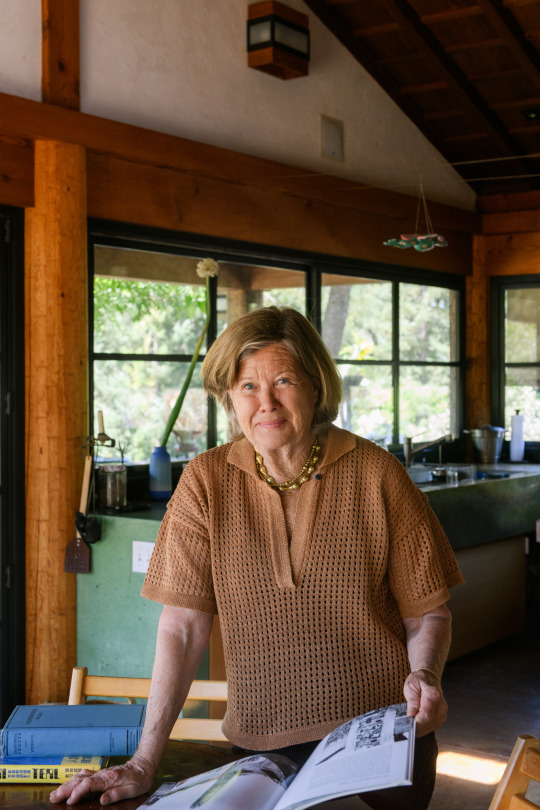
Ann Hatch has had many lives: ceramicist, entrepreneur, philanthropist, visionary founder of the Capp Street Project and the Oxbow School. “I believe ideas and projects have a relevance at a certain time… Things change. It is important to know when it is over,” she said to us, reflecting on a decades-long career that no matter its form has always centered on the arts, even as the city and the scene changes.
The other great constant in Hatch’s life, besides art, is her curiosity for culture. This was abundantly clear when we visited her home in Sebastopol earlier this year. Designed by her ex-husband, the architect and Buddhist priest Paul Discoe, the house is itself a work of art, with obvious Japanese influences and a respect for the materials, often left in their natural state. What makes this house Hatch’s own, however, are the artworks throughout—so perfectly selected that it is no surprise why Hatch has had success through all her personal reinventions.
Studio AHEAD: Years before we met, I came to your Sebastopol property—I didn’t know it was yours at the time—to pick up a piece by Jesse Schlesinger, who was living there. Tell us about this house, which was designed by Paul Discoe.
Ann Hatch: Designing and building a house with Paul was a unique experience. He had just started his construction business. Everything was done in the Japanese tradition. We had a terrific time designing and planning. We both had wild ideas. He could do them and make them unusually beautiful. When the project was finalized, we realized we really wanted to be together. Since we were both married that took some time. Paul is one of the most creative designers I had ever met—nothing was impossible. We shared a love of wood and using materials in creative but functional ways. He designed and built the New York apartment, as well.
Studio AHEAD: Do you regularly open up your home to artists?
Ann Hatch: There was a time when I had lots of receptions and parties. Now, I invite assorted people for small gatherings, mostly to the ranch. It’s fun to show them the details and materials of the house. I have, like everyone, realized how important my friends are. One benefit of getting old is the depth of friendship that we have.
Studio AHEAD: Is this the same kind of energy that pushed you to found the Capp Street Project?
Ann Hatch: I started Capp Street unexpectedly. I saw a David Ireland-designed house, which was for sale, empty. I met him on his birthday. I had a lot of apples in the car, which I took over to his personal residence to meet him. I soon agreed to buy the house he designed at 65 Capp Street without really knowing what I would do with it. But I knew it was a special space: I liked the changing light and sculptural elements, especially when it was empty. I knew the house could be a springboard for new ideas, not just a house. It was an immediate decision that you can’t explain. All my projects have started with a burst of confidence. I just knew it was the right idea for that time and needed to be done. I was fortunate to have the resources and advisors to get these projects started. In all cases my intention was that the project would be sustainable. It worked pretty well back then. (Things are different now).
Interestingly, my great grandfather T. B. Walker started the Walker Art Center out of his house. Maybe that had imprinted on me in some deep place. I moved quickly to develop the concept for an artist-in-residency, which was a new idea back in 1983. Artists were very enthusiastic about coming to San Francisco and making new work. We got the bravest and the best of the installation artists. Initially they made loose proposals; it was expected they would use S.F. or the house as a source of inspiration. I learned a great deal about Bay Area history from their projects: shredded money came from our mint, razor blades made from requisitioned cannons in the Presedio, seismic activity, recycled paper from Recology, and what people discard on the street. One collaborative team put fish hooks on all the street detritus around the building. We all had so much fun and realized amazingly bold ideas. The word spread fast among the artists—we were real and could do stuff! We facilitated the artists wishes, and that was thrilling.
Studio AHEAD: Could you have started Capp Street anywhere or was it something unique to the feel of San Francisco at the time? Perhaps it wouldn’t even be possible in San Francisco now.
Ann Hatch: Honestly, I would never be able to do a Capp Street project now. Everything is so charged and PC. I was born in S.F. and feel it has amazing qualities and depth. I wanted to see what artists would find interesting and worth focusing on. It might have worked in Chicago or any big city. Our artists, after 15 years, told us they were getting museum and gallery opportunities, which was great and why we closed. I believe ideas and projects have a relevance at a certain time. They can adapt and change sometimes, but it’s OK to "sunset" projects.
Later, I started Oxbow School in 1997, which we are closing after 25 years. I also closed Workshop Residence after 9 years when the pandemic hit. Things change. It is important to know when it is over.
Studio AHEAD: In the 80s and 90s you put on wild shows in your gallery: in one, the artist purposely flooded the exhibition space; in another, the street was extended right into the gallery, so that you couldn't tell which was interior/exterior. You have a much more adventurous, exploratory spirit than most patrons....
Ann Hatch: In the 80s it was a more adventurous and free time. There were lots of non-profit spaces that did great programs. The artists always wanted tech and unusual materials, which were difficult and challenging to find. Each residency exhibit was completely different. Capp Street Project had t-shirts that said "Weird things in a big room.” We had a small budget with lots of friends and connections. People wanted to be generous and part of these projects.
Studio AHEAD: What drew you to Napa to start the Oxbow School?
Ann Hatch: I was meeting the Mondavi family with a friend who was writing Robert Mondavi’s biography Harvest of Joy. My friend wanted to pitch Mondavi to fund a TV series of artists talking about their work. I said "no, that's a dreadful idea. Artists should not talk about their work… if I were Mondavis, I would start a school." So I was invited up to lunch… many lunches. I showed them many ways the arts can enrich young people and the community. He wanted to do something in the town of Napa that would have national impact. I quickly bought 15 pieces of property that were in the floodplain. It was across the river from his big project, Copia: The American Center for Wine, Food, & the Arts, which made it an "arts" district. Acquiring the properties was easy, as all the owners wanted out of the floodplain. The idea of having a semester for high school students with an arts focus was unique. Subjects taught in tandem with academics: English with painting, math with sculpture, for example. New ways of getting students thinking and engaged. Again, a bold idea that had its time. Oxbow did it really well, as the students say that I’ve changed their lives. I'm very proud of that.
Studio AHEAD: Twenty years ago you did a fascinating interview with Richard Whittaker and gave a great piece of advice to young artists: “You've got to be centered in what the work is about.” How have you remained centered in your own work?
Ann Hatch: That sounds preachy. I was probably thinking about the students at Oxbow School. If we could get the students focused in creative ways, they really blossomed. I have had the opportunity to start three projects. I've needed to be very focused on those to have them realized. Personally, I'm a bit hectic. I try to do too many things. That’s changing now...
In The Dogpatch you had Workshop Residence. Elena came after class from SFAI to a workshop headed by Max Lamb. Tell us about those times. Again I developed a plan for something that did not already exist. I wanted to have a store with limited editions of objects and work made by artists. Again , we rolled up our sleeves and made things with artists partners and fabricators. rugs made out of fire house, Sol Le Wit blankets, coffee cups made by 3D printing coffee grounds,, door stop made from skateboards, Perfume made locally, knot tieing Indigo and broom makingtied workshops, broom making,.etc
Studio AHEAD: Let's say I am a young person of certain means who wants to become a patron. What advice would you give? What has been most useful in your career?
Ann Hatch: Try new ideas that are within your means. Research what exists and find a niche. Be bold in concept. Use your friends and contacts. I needed an army for all my projects. It is one of the good parts of getting older, you have deep friendships. If you have financial resources, don’t be shy about using them in a constructive way. Starting projects takes energy, vision, and money. That’s nothing to be embarrassed about. I wanted to keep a low profile. Maybe that’s not possible now? If you’re making an impact, the word gets out by your deeds. Not social media.
Studio AHEAD: In a career of constantly looking forward, what is next for you?
Ann Hatch: I think my ceramics will hold my attention. I can control the whole process and keep learning. No board of directors, staff, or committees. I am enjoying doing porcelain portrait dog and cat bowls. People are crazy about their pets. They should have beautiful dinner dishes. It’s fun to capture their charming distinct expressions.
Studio AHEAD: Along with your house in Sebastopol, you have a home in the city, and also I think one in New York. Is there a commonality among all the houses you’ve lived in—something that makes you say to yourself, Yes this is my home.
Ann Hatch: Actually, all three are really different, which show I have many sides and interests.
Studio AHEAD: Can you share a favorite part of your house with us?
Ann Hatch: The morning and the shadows that play on the windows and surfaces. Each house has a unique character. The NYC apartment is so traditionally Japanese, it is like being in Japan. It’s very high contrast to the street energy. I see and think differently in each house. Outside at the ranch everything is fresh. You can hear things growing as I water the vegetables and assess the day. S.F. is home in lots of ways. I’m very lucky to have these places and I treasure them in different ways.
Photos by Ekaterina Izmestieva



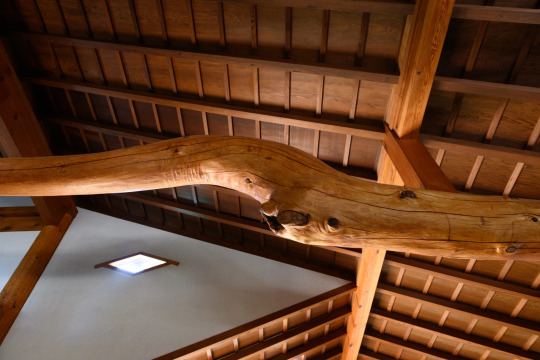



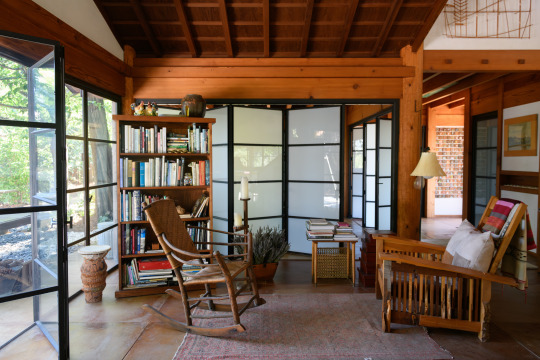
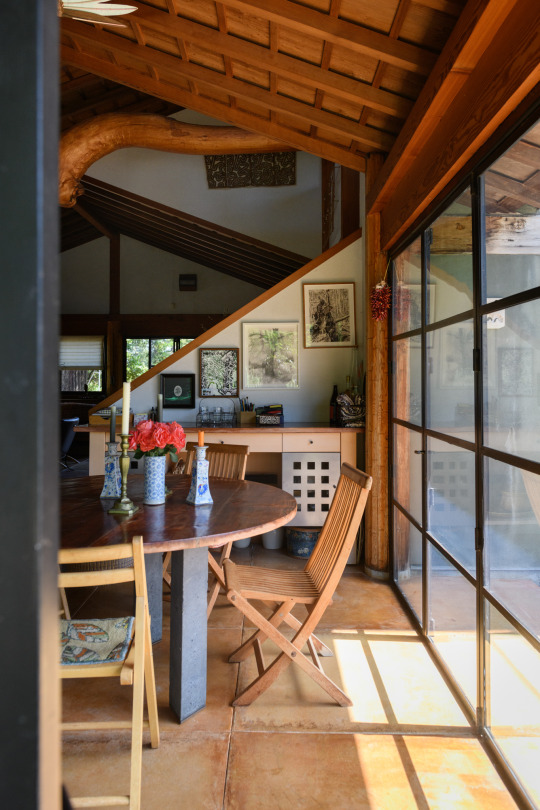
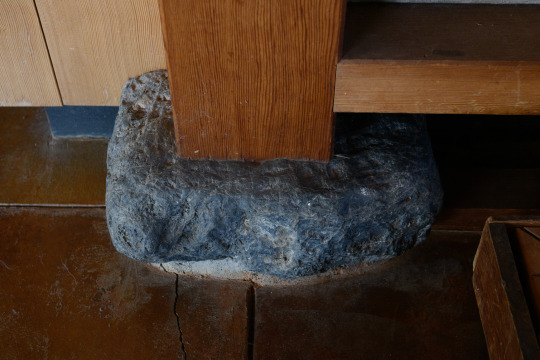

#studioahead#annhatch#ann hatch#northern california#bayarea#studio ahead#art#california#sonoma#sebastopol
1 note
·
View note